Student Spotlight: Summer with Théâtre de la Ville
As part of the 21st Century Artist Internships program, U-M students spend several weeks working with companies that are part of the UMS season. In 2014, 21st century student Héctor Flores Komatsu worked with Théâtre de la Ville in Paris, France.
Below, Flores shares his travel stories with the company. Théâtre de la Ville returns to Ann Arbor with L’État de siege (State of Siege) on October 13-14, 2017.
El Espíritu Oculto de la Olvidada Europa
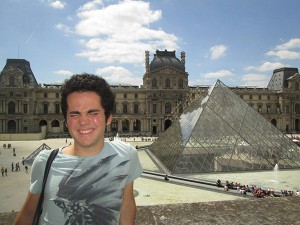
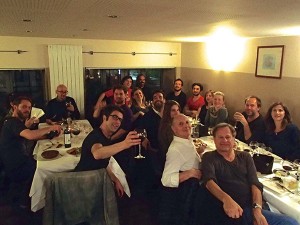
Photos: On the left, Flores in Paris. On the right, the company during dinner. All photos by Flores Komatsu.
The word “summer” has always had a very homey and rooted connotation to me. Road or plane trips that traverse borders were a staple of my upbringing. I’d look forward to the summers of eternal spring in my Mexican hometown, under the shade of the oscillating bugambilias, tantalized by the scent of Sunday morning house-spiced chorizo at my grandfather’s. If I owe my curiosity and affinity for the intercultural richness of the world to anything, it’s to the very familiar act of crossing borders.
I finally had the opportunity to venture away from the continent this summer, after Jim Leija [UMS Director of Education & Community Engagement] called to invite me to intern for UMS in Paris as part of the new 21st Century Artist Internship. I’d be leaving for France in three weeks.
And so, I took-off to Europe to intern with Théâtre de la Ville, Paris’s cultural institution for the performing arts (as well as an Ann Arbor and UMS favorite, having performed Ionesco’s Rhinocéros at the Power Center two seasons ago). I’d be working as a rehearsal assistant and media collector for their upcoming touring production of Six Characters in Search of an Author (to be performed at the Power Center October 24-25, 2014). All this presented itself, serendipitously, a mere two weeks before the end of my sophomore year at the University of Michigan — truly, an open door. Little did I know that, thanks to continuing serendipity, I wouldn’t set foot back in Ann Arbor until a few days before this Fall term.
Within minutes of boarding that plane, I instinctively felt that I was about to experience the most gratifying, unsettling, and enriching journey of my short years. It became a summer that has helped me to unearth my roots and left me with a hunger that’s been eating me alive, yet thankfully not eating me dead. I hope I can awaken a similar appetite in readers of this blog with my anecdotes from my time with Théâtre de la Ville (TDLV) and my first journey into the Old World.
Un Jeu des Rôles au Théâtre de la Ville
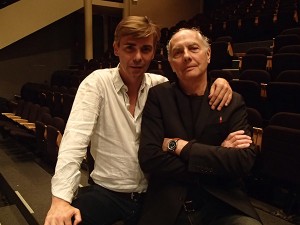
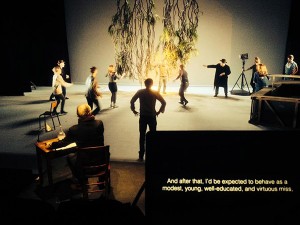
Photos: On the left, the two directors: Théâtre de la Ville director Emmanuel Demarcy-Mota and actor Alain Libolt, who plays the role of “Director” in Six Characters in Search of An Author. On the right, rehearsal with sub-titles.
Casually crossing the Pont Neuf on the Seine on the way to my first day, checking-out Notre Dame from the smoker’s balcony (though I don’t smoke), and then finishing my paperwork as the sun set against the Eiffel Tower seemed either the best cliché or too surreal to be true; but it was true, beauty on every corner. However, this type of initial beauty can grow stale with habit, and I quickly found beauty in the fondness my companions as well.
This type of beauty emerged when sharing a simple picnic with the company by the river at lunch, for example. I think the the vitality of a company originates from the unified pulse of its ensemble, that pulse that is universal in any theater venture, regardless of country. Sure, “stage-right” in French might be “the garden” (you can imagine the confusion for me, given that there’s an actual garden in the production). Sure, there may not be such a thing as blocking notes for re-stagings. And maybe the reasons for doing theater at all are very different. Still, the collaborative nature of theater is undeniable across the globe.
Six Characters in Search of an Author is play in which the dramatic truth is juxtaposed with immediate reality. Actors play actors, for example, while directors coach actors to play directors. The lines between performance and reality are crossed. For me, the ideas were constantly in translation as well. Yours truly was tasked with sub-titling the originally Italian text of the play (which is performed in French) into English. Ultimately, the goal for everyone involved, the director, the ensemble, and myself, was the same: To connect the inner life of the play to the outer life of the audience.
La culture ne marche pas!
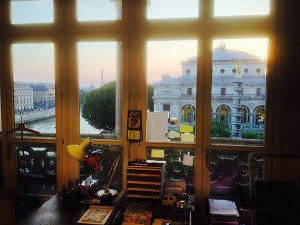
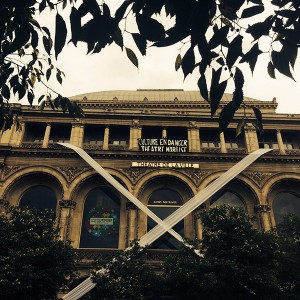
Photos: On left, sunset as viewed from the theater. On right, the theater, “X”-ed.
I spent two weeks in Italy (turns out speaking Spanish with an Italian inflection doesn’t actually mean you can speak Italian), and upon my return to Paris, I found culture in distress. “Culture,” substantially subsidized by the government and also supported by patrons, was immobilized and in peril due to some impending changes. To put it simply, recent overhauls to labor laws were to compromise the financial security, primarily through alterations to unemployment benefits, of “gypsy” professionals (including actors and stage hands), changing a system which (although not without faults) had long kept the performing arts alive, thriving, and, more importantly, relevant to the society.
The strongest impact on Théâtre de la Ville occurred during its annual city-wide performing arts festival Chantiers d’Europe. The festival saw various performances, all brought from abroad, cancelled as theater venues around the city shut down as part of a strike. TDLV, however remained strong. I learned perhaps my biggest lesson from [Théâtre de la Ville director] Emmanuel Demarcy-Mota when I saw him rally and inspire the company to, instead of shutting down the power of the stage at this time of turmoil, take advantage of the theater’s influence on the city and its audiences. In July, the façade of the theater was crossed with a large white “X” of defiance.
In the midst of the strikes came the opening night for a sold-out run of Pina Bausch – Wuppertal Tanztheatre, a yearly visitor and old friend of TDLV. The company was to perform the “wall”-breaking (both literally and figuratively) Palermo, Palermo. Dramatic truth came from an unexpected place in the bravest and most honest theatrical moment I got to witnessed in France.
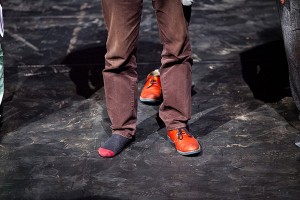
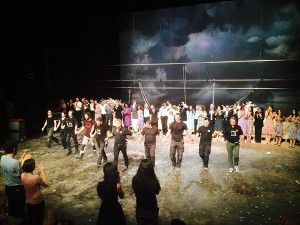
Photos: On left, Michael Chase. On right, company and stagehands bow together.
The co-head of the theater, Michael Chase, a reserved man of soft-spoken, tactful, iron words stood center-stage along his company in front of a full house. He softly said that without the workers of the theater, “La culture ne marche pas.” He bent down towards his signature red shoes, untied and removed one of them. He took a step forward as the rest of the company followed his actions.
Later, at the end of the performance, the dancers invited the stagehands, who had built for them, everyday, a brick wall that spanned the proscenium arch, and which tumbled and consequently needed rearranging by the stagehands mid-performance in plain view of the audience, to the stage. They joined the dancers. Everyone took a bow, every single one of them an artist without which “culture wouldn’t move”. And then the curtain fell.
Updated 6/2/2017.






